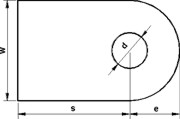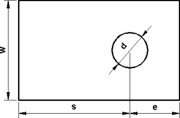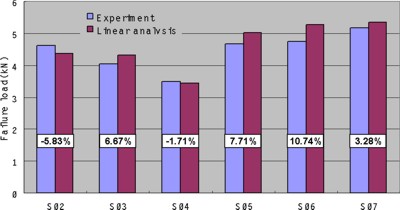
engineering & technology publications
ISSN 1759-3433
PROCEEDINGS OF THE SEVENTH INTERNATIONAL CONFERENCE ON COMPUTATIONAL STRUCTURES TECHNOLOGY
Failure Load Prediction of Mechanically Fastened Composite Joints using the Failure Area Index Method
Research Center for Aircraft Parts Technology, School of Mechanical and Aerospace Engineering, Gyeong-Sang National University, Jinju, Gyeongnam, Korea
| (62) |
The 7-type joint models which have the different ratios of the ![]() (width to hole
diameter) and
(width to hole
diameter) and ![]() (edge length to hole diameter) were manufactured and tested[10].
The carbon epoxy uni-directional prepreg and plane weave prepreg were used. The
stacking sequences of the specimens were
(edge length to hole diameter) were manufactured and tested[10].
The carbon epoxy uni-directional prepreg and plane weave prepreg were used. The
stacking sequences of the specimens were
![]() and
and
![]() . The "
. The "![]() " notation implies the plane weave carbon/epoxy layer.
Figure 1 shows the geometric shapes of the composite joint specimens.
The suggested failure area index method is shown to produce very favorable
comparisons with measured failure loads of mechanically fastened composite joints
with the difference well within 10.74% for all 17 cases investigated.
" notation implies the plane weave carbon/epoxy layer.
Figure 1 shows the geometric shapes of the composite joint specimens.
The suggested failure area index method is shown to produce very favorable
comparisons with measured failure loads of mechanically fastened composite joints
with the difference well within 10.74% for all 17 cases investigated.
- 1
- J.H. Choi, Y.J. Chun, "Failure Load Prediction of Mechanically Fastened Composite Joint", Journal of Composite Materials, Vol. 37, No. 24, pp. 2163-2177. doi:10.1177/002199803038108
- 2
- F.K. Chang, R.A. Scott,"Failure of Composite Laminates Containing Pin Loaded Holes-Method of Solution", Journal of Composite Materials, Vol. 18, pp. 255-278, 1984. doi:10.1177/002199838401800305
purchase the full-text of this paper (price £20)
go to the previous paper
go to the next paper
return to the table of contents
return to the book description
purchase this book (price £135 +P&P)


